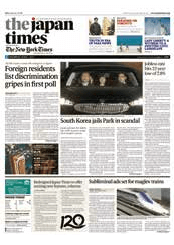Issue:
Japan’s largest English language daily has made some big moves to stay relevant and visually inviting.
The new Japan Times: reborn at 120

by GAVIN BLAIR
IN THE 12 DECADES since the Japan Times was launched, a multitude of English language newspapers have come and gone, many absorbed by the JT before the turn of the 20th century. In more recent years, the print editions of the Asahi Shimbun and Mainichi’s English editions have fallen by the wayside. The Japan News, the reincarnation of the Daily Yomiuri, survives, but now consists almost entirely of articles translated from the Yomiuri Shimbun.
Not content to rest on its last man standing laurels, and to better cope with the shift to the digital news age, the JT recently underwent its first major revamp in three decades, to coincide with its 120th anniversary. The paper changed its logo, font and layout, as well as increased use of photographs and graphics, for its relaunch on April 1.
The JT was the first English language newspaper in Japan to be founded by Japanese personnel and financing. Among the founding group were Yukichi Fukuzawa, he of the ¥10,000 note fame, and Sueji Yamada, a former secretary of Hirobumi Ito, Japan’s first prime minister of modern times and a key figure in establishing the Meiji Constitution. “The samurai era had just finished, and one of the aims was to show the real Japan to the world,” says Sayuri Daimon, the newspaper’s managing director.

The JT’s early look, with advertising concentrated on the front page, owed more than a little to the contemporary Times of London, according to Daimon. The paper went through a series of name changes, including one forced by the government to Nippon Times in 1943. “Although we were allowed to keep on publishing, there was censorship during the war and a push against English; even in baseball, terms like ‘strike’ were banned,” says Daimon.
The post war period, however, saw a burst in interest in the paper. “The paper sold like hotcakes when General MacArthur came because there were so many Americans here. And we had a lot of advertisers because they knew MacArthur was reading it,” explains Daimon.
FAST FORWARD TO 2013, when the JT was in the process of linking up with the New York Times international edition, then still the International Herald Tribune. Because the NYT publishes six days a week, the JT had an opportunity to experiment with a new format and designs on Sunday, according to art director Andrew Lee. The result was the tabloid sized Japan Times on Sunday and the stimulus for the complete overhaul of the daily edition that took place in April.
“We changed almost everything apart from the size. We shifted from eight columns to six per page; wider columns are better for longer reads,” says Lee. “People are more likely to read longer articles in print. But we’re different in that we have a lot of readers whose first language isn’t English, and they like to have shorter reads too.”
The new font is Berlingske Serif Text Light, designed for the Danish daily Berlingske, while Serif Black is used for the new all lower case logo, with its distinctive red dot on the first letter of japan. How the lower case jt logo looked online was a crucial factor, says Lee, as the publication aims to boost its digital imprint. Moving the masthead to the left side of the paper is designed to make it easier to find in newsstands. “On the first day of the relaunch I rushed down to the konbini and I could literally see it from outside; so I thought ‘that works,’” says Lee.
The print edition now has a circulation of around 45,000, produced by 30 writers, many of whom also have other roles at the paper, as well as a broad roster of freelancers. Although the JT has adopted a “web first” policy, “Print is the face of the paper,” says Daimon. “Sales jump significantly after big events such as the U.S. presidential election or when Obama came to Hiroshima. So even though there is a shift to online, people do still like to read about the big events in print.”
Daimon cites the incident last summer when a father left his son by the side of the road in Hokkaido as a punishment as the kind of reporting that sets the JT apart from both the Japanese and international media. “It was reported as if he was abandoned. People overseas wouldn’t leave their child on the street in the mountains. But given the safety level in Japan, parents sometimes do that,” she says. “You needed to explain that. We try to give details about cultural background, so we’re often more informative. Japanese papers often don’t give much background.”
“In the era of fake news, I think people are longing for trustworthy reporting. As long as we are based on real reporting, I think readers won’t leave us,” says Daimon. “Anybody can dispatch information. The difference is real journalism and reporting and we need to continue doing this.”
Gavin Blair covers Japanese business, society and culture for publications in the U.S., Asia and Europe.

